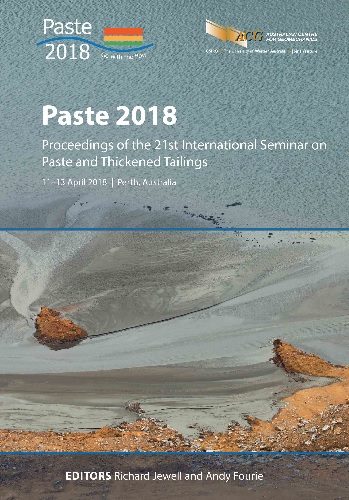Tailings filtration: risk reduction through understanding and designing for variability

|
Authors: de Kretser, RG |
DOI https://doi.org/10.36487/ACG_rep/1805_05_de_Kretser
Cite As:
de Kretser, RG 2018, 'Tailings filtration: risk reduction through understanding and designing for variability', in RJ Jewell & AB Fourie (eds), Paste 2018: Proceedings of the 21st International Seminar on Paste and Thickened Tailings, Australian Centre for Geomechanics, Perth, pp. 63-74, https://doi.org/10.36487/ACG_rep/1805_05_de_Kretser
Abstract:
In the face of recent high-profile tailings dam failures there has been an increased focus on the consideration of tailings filtration and dry stacking systems as an alternative to conventional or thickened discharge-based tailings management systems. However, whilst the potential benefits of a filtered tailings system can be significant, for instance in terms of water efficiency and reduced geotechnical risk, the high capital cost of such systems means that significant process or environmental drivers must typically exist to justify the expense. Furthermore, whilst larger-scale filtered tailings installations are now being successfully operated, such as in the alumina industry, there have also been operations that encountered significant problems leading to the tailings management system constraining overall plant productivity. In view of the significant capital investment required to implement a filtered tailings management system, understanding and mitigating key factors that could lead to tailings processing bottlenecks is therefore a critical part of the technical review of any proposed filtration and dry stacking system. In particular, the ability of the system to cope with potential variation in upstream process conditions or tailings material properties, or the risks associated with unanticipated such variation need careful consideration. However, sometimes the impacts of such variation are not clear from what is often relatively limited filter design testwork conducted on a limited range of samples, or the risks are not evident without taking a broader perspective beyond the filter plant alone. This paper illustrates, with the aid of model-based filtration simulations, examples of the nature and magnitude of typical system impacts due to factors such as variability in thickener underflow solids concentration and tailings dewaterability properties (whether due to variable plant feed or unexpected process conditions). System impacts discussed are not limited to high-level performance indicators such as filter throughput and cake solids concentrations, but will also consider filter design choice, filter operability, maintenance and downstream materials handling. Strategies for mitigation of these risks are also discussed. Whilst this work focused on membrane plate filters, the principles discussed are equally relevant to fixed cavity presses (and indeed other filter designs) and can assist in the design-making process of which type of filter best meets the needs of a given application.
Keywords: pressure filtration, process risk, feed solids concertation, optimisation, modelling
References:
Davies, M 2011, ‘Filtered dry stacked tailings – The fundamentals’, Proceedings of the 15th International Conference on Tailings and Mine Waste: Tailings and Mine Waste 2011, Norman B. Keevil Institute of Mining Engineering, University of British Columbia, Vancouver,
de Kretser, RG, Saha, HK & Scales, PJ 2010, ‘Semi-empirical full cycle optimisation of fill, squeeze and blow plate and frame pressure filters’, Chemical Engineering Science, vol. 65, no. 9, pp. 2700–2706.
de Kretser, RG & Scales, PJ 2011, ‘Exploring the influence of feed material properties on full cycle optimisation of fill, squeeze and blow plate and frame pressure filters’, Proceedings of FILTECH 2011, Filtech Exhibitions Germany, Meerbusch.
de Kretser, RG, Saha, HK, Biscombe, C & Scales, PJ 2011, ‘Plate and frame pressure filter optimisation using plant load cell data: Advantages, challenges and outcomes’, Proceedings of FILTECH 2009, Filtech Exhibitions Germany, Meerbusch, pp. 300–307.
Hore, C & Luppnow, D 2014, ‘Karara iron ore TSF – Design considerations for a unique large scale dry stack facility’, Proceedings of Tailings and Mine Waste 14, Colorado State University.
Mular, AL, Halbe, DN & Barratt, DJ (eds) 2002, Mineral processing plant design, practice and control: Proceedings, Volume 1, Society for Mining, Metallurgy, and Exploration, Englewood.
Stickland, AD, de Kretser, RG, Killcullen, AR, Scales, PJ, Hillis, P & Tillotson, MR 2008, ‘Numerical modeling of flexible-membrane plateand-frame filtration’, AIChE Journal, vol. 54, no. 2, pp. 464–474.
Wakeman, RJ & Tarleton, ES 1999, Filtration: Equipment selection, modelling and process simulation, Elsevier Advanced Technology, Oxford.
Zhou, Z, Scales, PJ & Boger, DV 2001, ‘Chemical and physical control of the rheology of concentrated metal oxide suspensions’, Chemical Engineering Science, vol. 56, no. 9, pp. 2901–2920.
© Copyright 2025, Australian Centre for Geomechanics (ACG), The University of Western Australia. All rights reserved.
View copyright/legal information
Please direct any queries or error reports to repository-acg@uwa.edu.au
View copyright/legal information
Please direct any queries or error reports to repository-acg@uwa.edu.au



